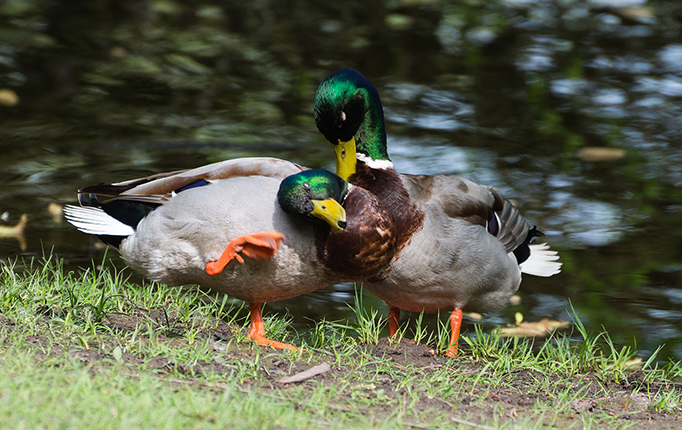
Two male mallard ducks. Mallards are one of a wide variety of species that exhibit same-sex sexual behavior. Image via Wikimedia Commons.
Ever since Darwin first theorized that evolution was driven by natural and sexual selection, evolutionary biologists have puzzled over same-sex sexual behavior (SSB) in animals. SSB is widespread and has been observed in more than 1,500 animal species—from sea urchins and damselflies to flying foxes and garter snakes.
But SSB has presented evolutionary biologists with a longstanding “Darwinian paradox”: SSB has evolved across many species and persisted, even though the expenditure of valuable energy—with a lack of resultant offspring—would be expected to impede an animal’s survival.
In a recent perspective paper published in Nature Ecology & Evolution, Max Lambert and Ambika Kamath—both postdoctoral researchers in the Department of Environmental Science, Policy, and Management—suggest that conventional assumptions about the origins, costs, and benefits of SSB deserve more scrutiny. Questioning whether different-sex behavior is as foundational to early animal evolution as widely believed, the authors suggest that indiscriminate sexual behavior (regardless of sex) could offer a more accurate baseline for study.
“The notion that SSB has arisen convergently in so many different lineages only makes intuitive sense from a heteronormative world view in which ‘heterosexual’ behavior is framed as the ‘natural order’ for sexually reproducing species, and ‘homosexuality’ is viewed as a recent aberration whose existence must be explained and justified,” the authors write in the study.
Importantly, the authors stop short of applying the research to human sexuality. Culture has too significant of an impact, they argue, while normative arguments about people lay outside the realm of science.
“Scientists should be thoughtful about the critical lenses, biases and assumptions we bring to the process of asking questions, designing experiments and interpreting results,” write the authors in an op-ed in Scientific American. “Widening the range of perspectives and cultures that have a voice in academic science is critical to the improvement of scientific practice and knowledge-building.”
Lambert and Kamath collaborated with corresponding author Julia Monk at Yale, as well as researchers at Syracuse University and the University of Texas at Austin. To learn more, see the recent coverage in The New York Times, The Economist, and Scientific American below.
READ MORE:
- Seeking a New Lens to Study Same-Sex Behavior in Animals (The New York Times)
- A new theory argues same-sex sexual behaviour is an evolutionary norm (The Economist)
- Why is Same-sex Sexual Behavior so Common in Animals? (Scientific American)
- An alternative hypothesis for the evolution of same-sex sexual behavior in animals (Nature Ecology & Evolution)
- How gendered language leads scientists astray (The Washington Post)
